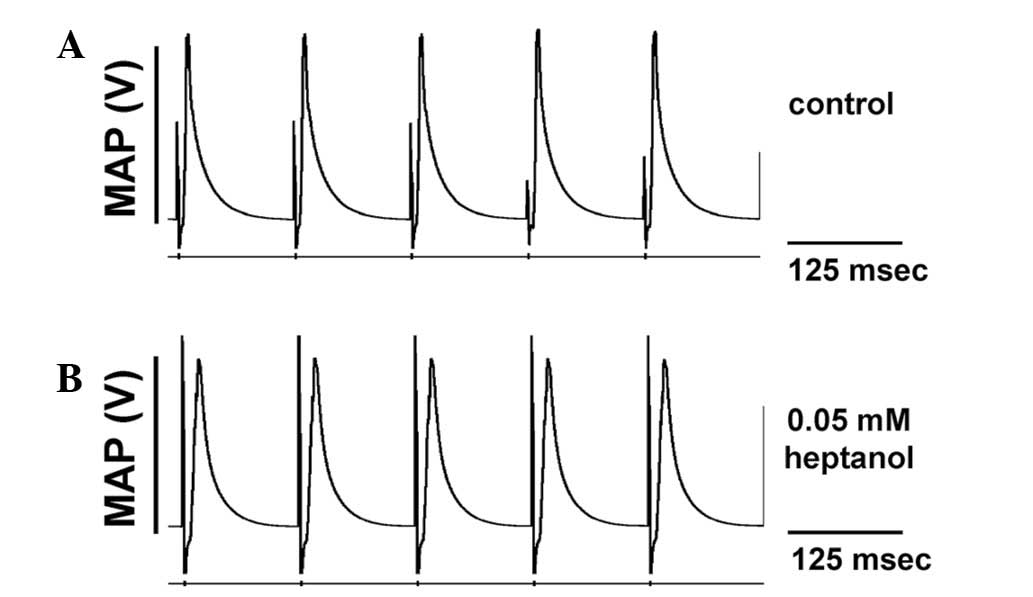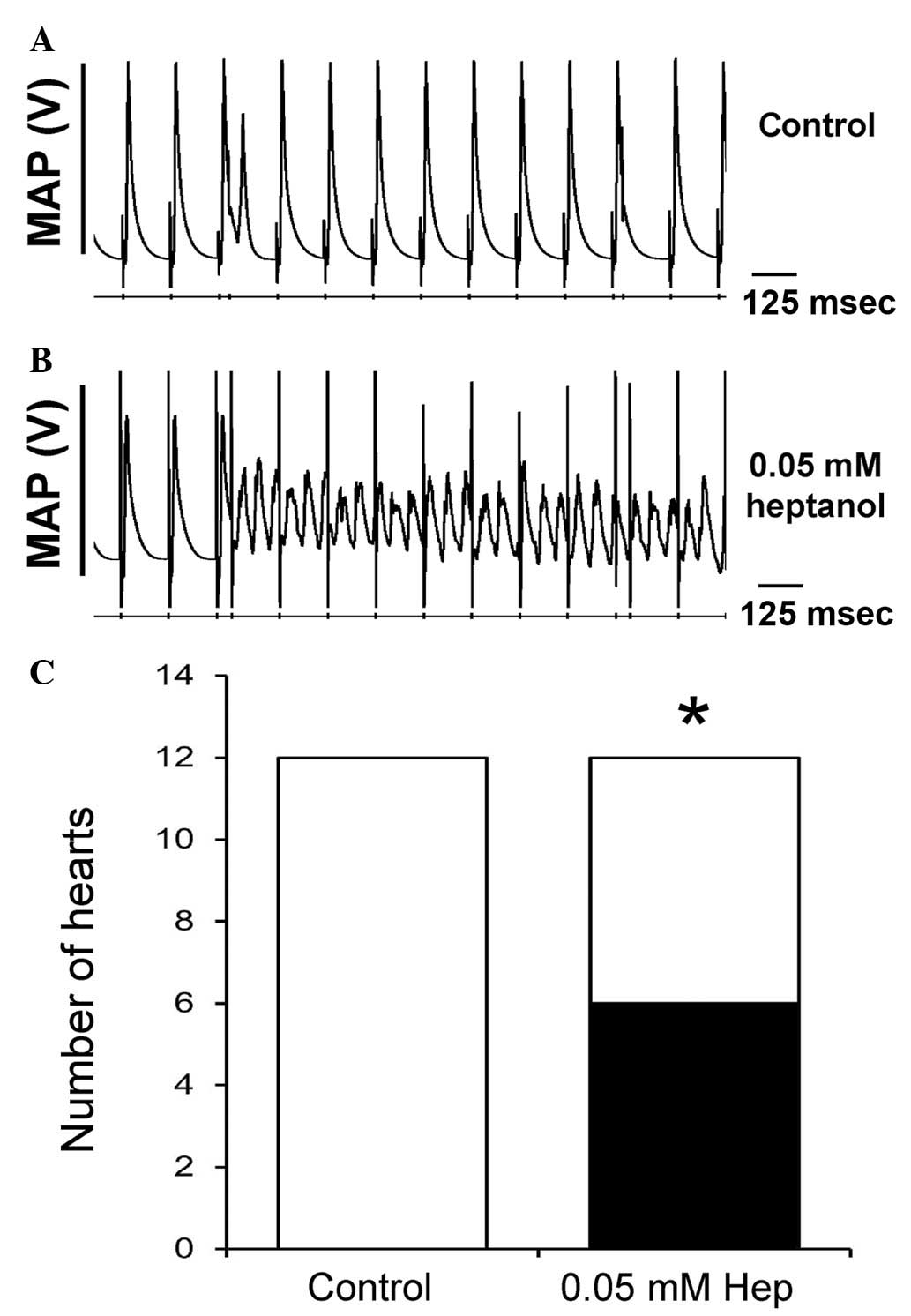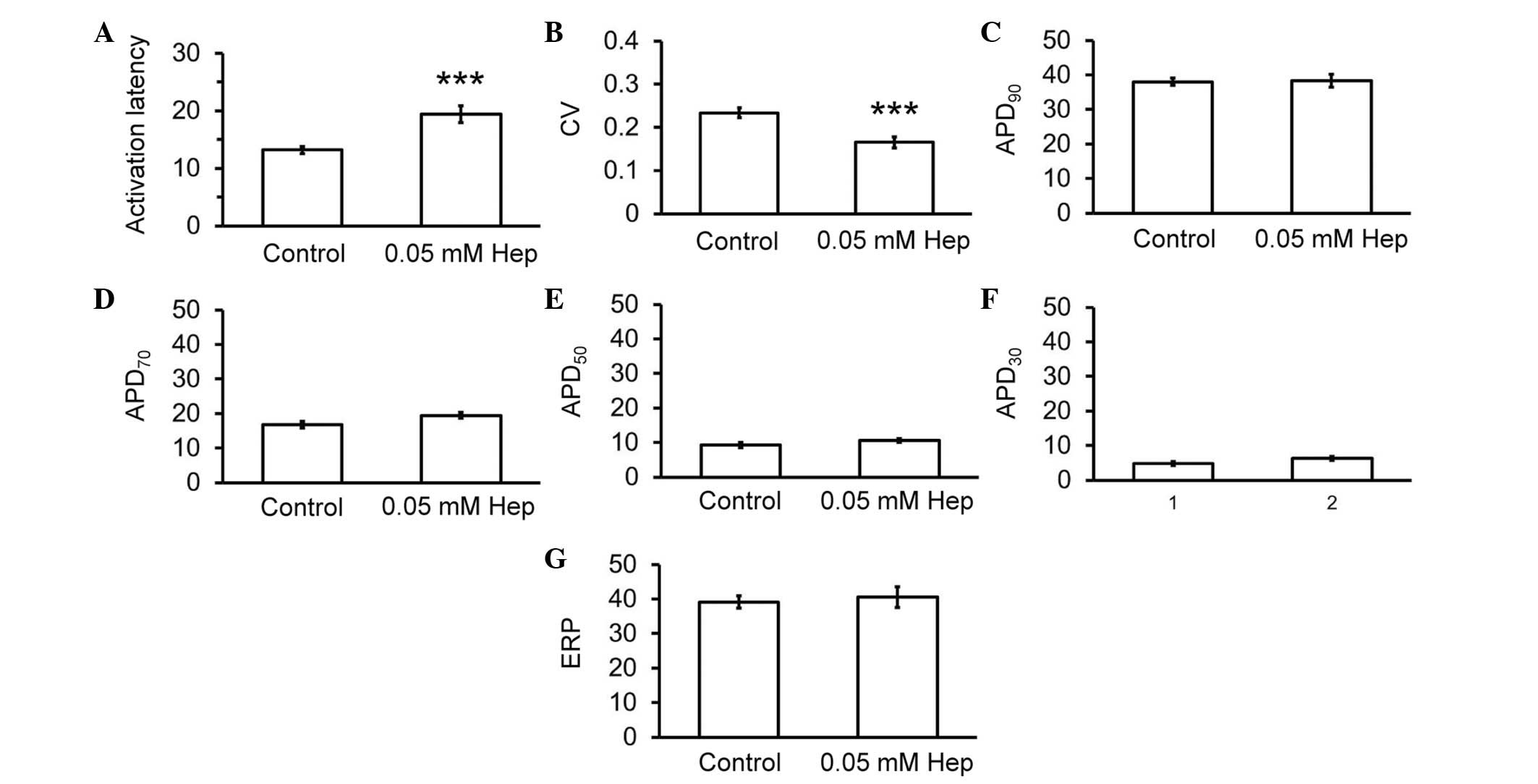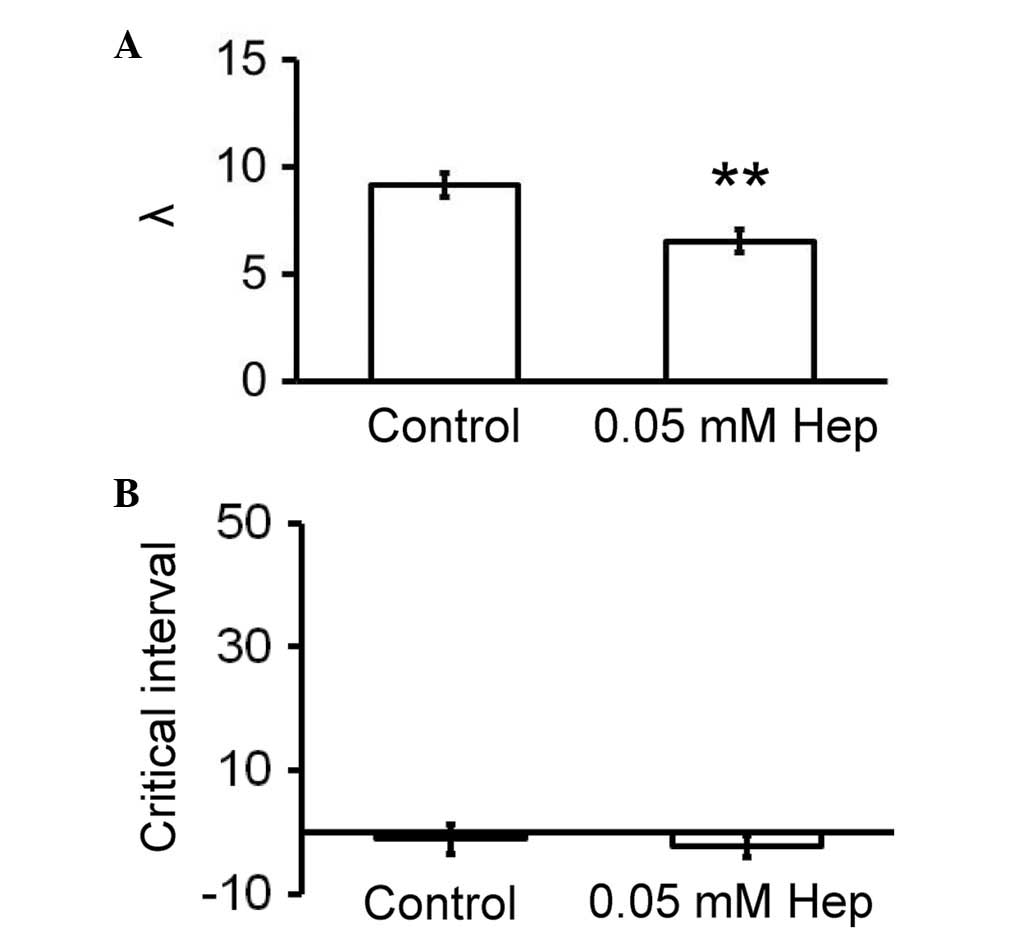|
1
|
Tse G: Both transmural dispersion of
repolarization and transmural dispersion of refractoriness are poor
predictors of arrhythmogenicity: A role for the index of Cardiac
Electrophysiological Balance (QT/QRS)? J Geriatr Cardiol. 2016.
|
|
2
|
Tse G, Tse V and Yeo JM: Ventricular
anti-arrhythmic effects of heptanol in hypokalaemic,
Langendorff-perfused mouse hearts. Biomed Rep. 4:313–324.
2016.PubMed/NCBI
|
|
3
|
Tse G, Tse V, Yeo JM and Sun B: Atrial
anti-arrhythmic effects of heptanol in Langendorff-perfused mouse
hearts. PLoS One. 11:e01488582016. View Article : Google Scholar : PubMed/NCBI
|
|
4
|
Tse G: Mechanisms of cardiac arrhythmias.
J Arrhythm. 32:75–81. 2016. View Article : Google Scholar : PubMed/NCBI
|
|
5
|
Tse G, Wong ST, Tse V and Yeo JM:
Restitution analysis of alternans using dynamic pacing and its
comparison with S1S2 restitution in heptanol-treated, hypokalaemic
Langendorff-perfused mouse hearts. Biomed Rep. 4:673–680.
2016.PubMed/NCBI
|
|
6
|
Tse G and Yeo JM: Conduction abnormalities
and ventricular arrhythmogenesis: The roles of sodium channels and
gap junctions. Int J Cardiol Heart Vasc. 9:75–82. 2015.PubMed/NCBI
|
|
7
|
Tse G, Hothi SS, Grace AA and Huang CL:
Ventricular arrhythmogenesis following slowed conduction in
heptanol-treated, Langendorff-perfused mouse hearts. J Physiol Sci.
62:79–92. 2012. View Article : Google Scholar : PubMed/NCBI
|
|
8
|
Tse G, Wong ST, Tse V and Yeo JM:
Monophasic action potential recordings: Which is the recording
electrode? J Basic Clin Physiol Pharmacol. 2016. View Article : Google Scholar : PubMed/NCBI
|
|
9
|
Tse G, Lai TH, Yeo JM, Tse V and Wong SH:
Mechanisms of electrical activation and conduction in the
gastrointestinal system: Lessons from cardiac electrophysiology.
Front Physiol. 7:1822016. View Article : Google Scholar : PubMed/NCBI
|
|
10
|
Tse G, Wong ST, Tse V and Yeo JM:
Depolarization vs. repolarization: What is the mechanism of
ventricular arrhythmogenesis underlying sodium channel
haploinsufficiency in mouse hearts? Acta Physiol (Oxf). 2016.
View Article : Google Scholar : PubMed/NCBI
|
|
11
|
Chen Z, Sun B, Tse G, Jiang J and Xu W:
Reversibility of both sinus node dysfunction and reduced HCN4 mRNA
expression level in an atrial tachycardia pacing model of
tachycardia-bradycardia syndrome in rabbit hearts. Int J Clin Exp
Pathol. 9:2016.
|
|
12
|
Tse G, Sun B, Wong ST, Tse V and Yeo JM:
Ventricular anti-arrhythmic effects of hypercalcaemia treatment in
hyperkalaemic, Langendorff-perfused mouse hearts. Biomed Rep.
4:313–324. 2016.PubMed/NCBI
|
|
13
|
Tse G, Lai ET, Tse V and Yeo JM: Molecular
and electrophysiological mechanisms underlying cardiac
arrhythmogenesis in diabetes mellitus. J Diabetes Res. 2016.(In
press). View Article : Google Scholar : PubMed/NCBI
|
|
14
|
Tse G, Wong ST, Tse V and Yeo JM:
Determination of action potential wavelength restitution in
Scn5a+/− mouse hearts modelling human Brugada syndrome. J Physiol.
2016.(In press).
|
|
15
|
Osadchii OE: Flecainide-induced
proarrhythmia is attributed to abnormal changes in repolarization
and refractoriness in perfused guinea-pig heart. J Cardiovasc
Pharmacol. 60:456–466. 2012. View Article : Google Scholar : PubMed/NCBI
|
|
16
|
Osadchii OE: Quinidine elicits
proarrhythmic changes in ventricular repolarization and
refractoriness in guinea-pig. Can J Physiol Pharmacol. 91:306–315.
2013. View Article : Google Scholar : PubMed/NCBI
|
|
17
|
Wilde AA, Postema PG, Di Diego JM, Viskin
S, Morita H, Fish JM and Antzelevitch C: The pathophysiological
mechanism underlying Brugada syndrome: Depolarization versus
repolarization. J Mol Cell Cardiol. 49:543–553. 2010. View Article : Google Scholar : PubMed/NCBI
|
|
18
|
Osadchii OE: Impact of hypokalemia on
electromechanical window, excitation wavelength and repolarization
gradients in guinea-pig and rabbit hearts. PLoS One. 9:e1055992014.
View Article : Google Scholar : PubMed/NCBI
|
|
19
|
Osadchii OE: Impaired epicardial
activation-repolarization coupling contributes to the proarrhythmic
effects of hypokalaemia and dofetilide in guinea pig ventricles.
Acta Physiol (Oxf). 211:48–60. 2014. View Article : Google Scholar : PubMed/NCBI
|
|
20
|
Hsieh YC, Lin JC, Hung CY, Li CH, Lin SF,
Yeh HI, Huang JL, Lo CP, Haugan K, Larsen BD and Wu TJ: Gap
junction modifier rotigaptide decreases the susceptibility to
ventricular arrhythmia by enhancing conduction velocity and
suppressing discordant alternans during therapeutic hypothermia in
isolated rabbit hearts. Heart Rhythm. 13:251–261. 2016. View Article : Google Scholar : PubMed/NCBI
|
|
21
|
Hsieh YC, Lin SF, Huang JL, Hung CY, Lin
JC, Liao YC, Lo CP, Wang KY and Wu TJ: Moderate hypothermia (33°C)
decreases the susceptibility to pacing-induced ventricular
fibrillation compared with severe hypothermia (30°C) by attenuating
spatially discordant alternans in isolated rabbit hearts. Zhonghua
Minguo Xin Zang Xue Hui Za Zhi. 30:455–465. 2014.
|
|
22
|
Hsieh YC, Lin SF, Lin TC, Ting CT and Wu
TJ: Therapeutic hypothermia (30 degrees C) enhances arrhythmogenic
substrates, including spatially discordant alternans, and
facilitates pacing-induced ventricular fibrillation in isolated
rabbit hearts. Circ J. 73:2214–2222. 2009. View Article : Google Scholar : PubMed/NCBI
|
|
23
|
Choy L, Yeo JM, Tse V, Chan SP and Tse G:
Cardiac disease and arrhythmogenesis: Mechanistic insights from
mouse studies. Int J Cardiol Heart Vasc. 12:1–10. 2016.PubMed/NCBI
|
|
24
|
Tse G, Lai ET, Chan YWF, Yeo JM and Yan
BP: What is the arrhythmic substrate in viral myocarditis? Insights
from clinical and animal studies. Front Physiol. 7:3082016.
View Article : Google Scholar : PubMed/NCBI
|
|
25
|
Stein M, van Veen TA, Remme CA, Boulaksil
M, Noorman M, van Stuijvenberg L, van der Nagel R, Bezzina CR,
Hauer RN, de Bakker JM and van Rijen HV: Combined reduction of
intercellular coupling and membrane excitability differentially
affects transverse and longitudinal cardiac conduction. Cardiovasc
Res. 83:52–60. 2009. View Article : Google Scholar : PubMed/NCBI
|
|
26
|
Stein M, van Veen TA, Hauer RN, de Bakker
JM and van Rijen HV: A 50% reduction of excitability but not of
intercellular coupling affects conduction velocity restitution and
activation delay in the mouse heart. PLoS One. 6:e203102011.
View Article : Google Scholar : PubMed/NCBI
|
|
27
|
Morley GE, Vaidya D, Samie FH, Lo C,
Delmar M and Jalife J: Characterization of conduction in the
ventricles of normal and heterozygous Cx43 knockout mice using
optical mapping. J Cardiovasc Electrophysiol. 10:1361–1375. 1999.
View Article : Google Scholar : PubMed/NCBI
|
|
28
|
George SA, Sciuto KJ, Lin J, Salama ME,
Keener JP, Gourdie RG and Poelzing S: Extracellular sodium and
potassium levels modulate cardiac conduction in mice heterozygous
null for the Connexin43 gene. Pflugers Arch. 467:2287–2297. 2015.
View Article : Google Scholar : PubMed/NCBI
|
|
29
|
Vaidya D, Tamaddon HS, Lo CW, Taffet SM,
Delmar M, Morley GE and Jalife J: Null mutation of connexin43
causes slow propagation of ventricular activation in the late
stages of mouse embryonic development. Circ Res. 88:1196–1202.
2001. View Article : Google Scholar : PubMed/NCBI
|
|
30
|
van Rijen HV, Eckardt D, Degen J, Theis M,
Ott T, Willecke K, Jongsma HJ, Opthof T and de Bakker JM: Slow
conduction and enhanced anisotropy increase the propensity for
ventricular tachyarrhythmias in adult mice with induced deletion of
connexin43. Circulation. 109:1048–1055. 2004. View Article : Google Scholar : PubMed/NCBI
|
|
31
|
Guerrero PA, Schuessler RB, Davis LM,
Beyer EC, Johnson CM, Yamada KA and Saffitz JE: Slow ventricular
conduction in mice heterozygous for a connexin43 null mutation. J
Clin Invest. 99:1991–1998. 1997. View Article : Google Scholar : PubMed/NCBI
|
|
32
|
Thomas SA, Schuessler RB, Berul CI,
Beardslee MA, Beyer EC, Mendelsohn ME and Saffitz JE: Disparate
effects of deficient expression of connexin43 on atrial and
ventricular conduction: Evidence for chamber-specific molecular
determinants of conduction. Circulation. 97:686–691. 1998.
View Article : Google Scholar : PubMed/NCBI
|
|
33
|
Eloff BC, Lerner DL, Yamada KA, Schuessler
RB, Saffitz JE and Rosenbaum DS: High resolution optical mapping
reveals conduction slowing in connexin43 deficient mice. Cardiovasc
Res. 51:681–690. 2001. View Article : Google Scholar : PubMed/NCBI
|
|
34
|
Christ GJ, Spektor M, Brink PR and Barr L:
Further evidence for the selective disruption of intercellular
communication by heptanol. Am J Physiol. 276:H1911–H1917.
1999.PubMed/NCBI
|
|
35
|
Rüdisüli A and Weingart R: Electrical
properties of gap junction channels in guinea-pig ventricular cell
pairs revealed by exposure to heptanol. Pflugers Arch. 415:12–21.
1989. View Article : Google Scholar : PubMed/NCBI
|
|
36
|
Nelson WL and Makielski JC: Block of
sodium current by heptanol in voltage-clamped canine cardiac
Purkinje cells. Circ Res. 68:977–983. 1991. View Article : Google Scholar : PubMed/NCBI
|
|
37
|
Balasubramaniam R, Grace AA, Saumarez RC,
Vandenberg JI and Huang CL: Electrogram prolongation and
nifedipine-suppressible ventricular arrhythmias in mice following
targeted disruption of KCNE1. J Physiol. 552:535–546. 2003.
View Article : Google Scholar : PubMed/NCBI
|
|
38
|
Knollmann BC, Katchman AN and Franz MR:
Monophasic action potential recordings from intact mouse heart:
Validation, regional heterogeneity, and relation to refractoriness.
J Cardiovasc Electrophysiol. 12:1286–1294. 2001. View Article : Google Scholar : PubMed/NCBI
|
|
39
|
Gussak I, Chaitman BR, Kopecky SL and
Nerbonne JM: Rapid ventricular repolarization in rodents:
Electrocardiographic manifestations, molecular mechanisms, and
clinical insights. J Electrocardiol. 33:159–170. 2000. View Article : Google Scholar : PubMed/NCBI
|
|
40
|
Fabritz L, Kirchhof P, Franz MR, Eckardt
L, Mönnig G, Milberg P, Breithardt G and Haverkamp W: Prolonged
action potential durations, increased dispersion of repolarization,
and polymorphic ventricular tachycardia in a mouse model of
proarrhythmia. Basic Res Cardiol. 98:25–32. 2003. View Article : Google Scholar : PubMed/NCBI
|
|
41
|
Wiener N and Rosenblueth A: The
mathematical formulation of the problem of conduction of impulses
in a network of connected excitable elements, specifically in
cardiac muscle. Arch Inst Cardiol Mex. 16:205–265. 1946.PubMed/NCBI
|
|
42
|
Implantable cardioverter defibrillators
for arrhythmias, . Review of technology appraisal 11. National
Institute for Health and Clinical Excellence (NICE); 2007
|
|
43
|
Adabag AS, Luepker RV, Roger VL and Gersh
BJ: Sudden cardiac death: Epidemiology and risk factors. Nat Rev
Cardiol. 7:216–225. 2010. View Article : Google Scholar : PubMed/NCBI
|
|
44
|
Chugh SS, Reinier K, Teodorescu C, Evanado
A, Kehr E, Al Samara M, Mariani R, Gunson K and Jui J: Epidemiology
of sudden cardiac death: Clinical and research implications. Prog
Cardiovasc Dis. 51:213–228. 2008. View Article : Google Scholar : PubMed/NCBI
|
|
45
|
Spray DC and Burt JM: Structure-activity
relations of the cardiac gap junction channel. Am J Physiol.
258:C195–C205. 1990.PubMed/NCBI
|
|
46
|
Dhillon PS, Gray R, Kojodjojo P, Jabr R,
Chowdhury R, Fry CH and Peters NS: Relationship between
gap-junctional conductance and conduction velocity in mammalian
myocardium. Circ Arrhythm Electrophysiol. 6:1208–1214. 2013.
View Article : Google Scholar : PubMed/NCBI
|
|
47
|
Peters NS: Gap junctions: Clarifying the
complexities of connexins and conduction. Circ Res. 99:1156–1158.
2006. View Article : Google Scholar : PubMed/NCBI
|
|
48
|
Gutstein DE, Morley GE, Tamaddon H, Vaidya
D, Schneider MD, Chen J, Chien KR, Stuhlmann H and Fishman GI:
Conduction slowing and sudden arrhythmic death in mice with
cardiac-restricted inactivation of connexin43. Circ Res.
88:333–339. 2001. View Article : Google Scholar : PubMed/NCBI
|
|
49
|
Beauchamp P, Choby C, Desplantez T, de
Peyer K, Green K, Yamada KA, Weingart R, Saffitz JE and Kléber AG:
Electrical propagation in synthetic ventricular myocyte strands
from germline connexin43 knockout mice. Circ Res. 95:170–178. 2004.
View Article : Google Scholar : PubMed/NCBI
|
|
50
|
Veeraraghavan R, Salama ME and Poelzing S:
Interstitial volume modulates the conduction velocity-gap junction
relationship. Am J Physiol Heart Circ Physiol. 302:H278–H286. 2012.
View Article : Google Scholar : PubMed/NCBI
|
|
51
|
Hondeghem LM: QTc prolongation as a
surrogate for drug-induced arrhythmias: Fact or fallacy? Acta
Cardiol. 66:685–689. 2011.PubMed/NCBI
|
|
52
|
Vigmond EJ: The electrophysiological basis
of MAP recordings. Cardiovasc Res. 68:502–503. 2005. View Article : Google Scholar : PubMed/NCBI
|
|
53
|
Vigmond EJ and Leon LJ:
Electrophysiological basis of mono-phasic action potential
recordings. Med Biol Eng Comput. 37:359–365. 1999. View Article : Google Scholar : PubMed/NCBI
|
|
54
|
Tse G: Novel conduction-repolarization
indices for the stratification of arrhythmic risk. J Geriatr
Cardiol. 2016.(Accepted).
|
|
55
|
Tse G: (Tpeak-Tend)/QRS and
(Tpeak-Tend)/(QT x QRS): Novel markers for predicting arrhythmic
risk in Brugada syndrome. Europace. 2016.(Accepted). View Article : Google Scholar
|
|
56
|
Tse G and Yan BP: Novel arrhythmic risk
markers incorporating QRS dispersion: QRSd x (Tpeak-Tend)/QRS and
QRSd x (Tpeak-Tend)/(QT x QRS). Ann Noninvasive Electrocardiol.
2016.(Accepted). View Article : Google Scholar : PubMed/NCBI
|
|
57
|
Tse G, Lai ET, Yeo JM and Yan BP:
Electrophysiological mechanisms of Bayés syndrome: Insights from
clinical and mouse studies. Front Physiol. 7:1882016. View Article : Google Scholar : PubMed/NCBI
|
|
58
|
Tse G, Lai ET, Lee AP, Yan BP and Wong SH:
Electrophysiological mechanisms of gastrointestinal
arrhythmogenesis: Lessons from the heart. Front Physiol. 7:2016.
View Article : Google Scholar
|
|
59
|
Tse G, Wong ST, Tse V and Yeo JM:
Variability in local action potential durations, dispersion of
repolarization and wavelength restitution in aged wild-type and
Scn5a+/− mouse hearts modelling human Brugada syndrom. J Geriatr
Cardiol. 2016.(Accepted).
|
|
60
|
Tse G, Ali A, Alpendurada F, Prasad S,
Raphael CE and Vassiliou V: Tuberculous constrictive pericarditis.
Res Cardiovasc Med. 4:e296142015. View Article : Google Scholar : PubMed/NCBI
|
|
61
|
Tse G, Ali A, Prasad SK, Vassiliou V and
Raphael CE: Atypical case of post-partum cardiomyopathy: An overlap
syndrome with arrhythmogenic right ventricular cardiomyopathy?
BJR|case reports. 1:201501822015. View Article : Google Scholar
|
|
62
|
Vassiliou V, Chin C, Perperoglou A, Tse G,
Ali A, Raphael C, Jabbour A, Newby D, Pennell D, Dweck D and Prasad
S: 93 ejection fraction by cardiovascular magnetic resonance
predicts adverse outcomes post aortic valve replacement. Heart.
100:A53–A54. 2014. View Article : Google Scholar
|
|
63
|
Ono Y and Ishiyama A: Non-invasive cardiac
functional mapping on disease-model mice-development of high
spatial resolution SQUID system for MCG on mice. Teion Kogaku.
40:44–50. 2005. View Article : Google Scholar
|
|
64
|
Tse G and Yan BP: Traditional and novel
ECG conduction and repolarization markers of sudden cardiac death.
Europace. 2016.(In press).
|
|
65
|
Tse G, Yan BP, Chan YW, Tian XY and Huang
Y: Reactive oxygen species, endoplasmic reticulum stress and
mitochondrial dysfunction: the link with cardiac arrhythmogenesis.
Front Physiol. 7:3132016. View Article : Google Scholar : PubMed/NCBI
|
|
66
|
Hu Z, Chen Z, Wang Y, Jiang J, Tse G, Xu
W, Ge J and Sun B: Effects of granulocyte colony-stimulating factor
on rabbit carotid and swine heart models of chronic obliterative
arterial disease. Mol Med Rep. 2016.(Accepted).
|


















